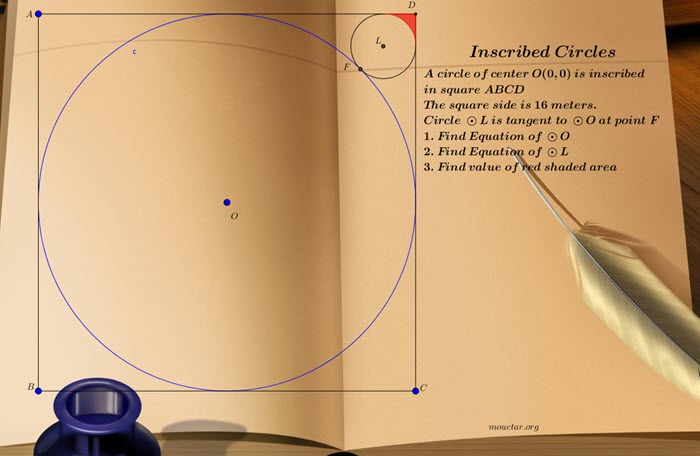

Inscribed circles, from the lounge
Problem 23:
A circle of center ![]() has been inscribed in a square ABCD, of side 16 meters.
has been inscribed in a square ABCD, of side 16 meters.
In the following figure, a smaller circle of center ![]() and tangent of Circle
and tangent of Circle ![]() at
at ![]() has been inscribed per figure.
has been inscribed per figure.
1. What is the equation of ![]() ?
?
2. What is the equation of the small circle ![]() ?
?
3.What is the area of the colored area?
(All calculations to be to the thousandth)

SOLUTION
The circle center ![]()

General Equation of a circle of center ![]() is:
is:
![]()
We can see that the radius is half of the width of the square.
![]()
![]()
Now let’s draw aline passing through points ![]() and
and ![]()
Points ![]() coordinates
coordinates ![]()
Distance ![]() :
:
![]()
Distance ![]()
![]()
The line passing through ![]()
![]()
It’s perpendicular line ![]() has a slope of
has a slope of ![]() .
.
That line passes through the tangency point ![]() .
.
Coordinates of ![]()
![]()
For point ![]() :
:
![]()
Line ![]() passes through
passes through ![]() with a slope of
with a slope of ![]() . We use the general form:
. We use the general form:
![]()
![]()
![]()
![]()
This is the equation of line ![]() .
.
![]()
Line ![]() meets the square in two points
meets the square in two points ![]() and
and ![]()
For point ![]() :
:
Point ![]() is the intersection of lines
is the intersection of lines ![]() and line
and line ![]() or
or ![]()
We get at ![]() :
:
![]()
![]()
![]()
Finally:
![]()
Or:
![]()
For point ![]() :
:

Point ![]() is the intersection of lines
is the intersection of lines ![]() and line
and line ![]() or
or ![]()
Let’s plug in the value of ![]() :
:
For point ![]() :
:
![]()
So:
![]()
Or:
![]()
Now we can see the triangle ![]()
Circle ![]() is inscribed in
is inscribed in ![]() with
with ![]() being the incenter.
being the incenter.
Lines from any vertex bisects that vertex.
We see that angle:
![]()
The line from vertex ![]() to
to ![]() will make an angle of
will make an angle of ![]()
Let’s find it’s tangent or the slope.
![]()
From our formula page:
![]()
![]()
![]()
![]() . This is the slope.
. This is the slope.
The line ![]() passes through
passes through ![]()
![]()
We use the standard equation:
![]()
![]()
![]()
![]()
![]()
The lines ![]() and
and ![]() intersect at the incenter
intersect at the incenter ![]() , center of
, center of ![]()
We get:
![]()
![]()
![]()
![]()
![]()
![]()
![]()
Since the point ![]() is on
is on ![]() :
:
![]()
The length ![]() is the radius of
is the radius of ![]()
Let’s calculate that distance:
![]()
![]()
![]()
![]()
![]()
![]()
If ![]() is the radius of
is the radius of ![]() :
:
![]()
Let’s use decimals to simplify:
![]()
Equation of the circle:
![]()
Or in decimals:
![]()
Now for the final question we have to take a look at the graph:
The shaded is simply the difference between the areas of ![]() and circle segment of arc
and circle segment of arc ![]()
Let’s calculate that difference.
Triangle ![]() is a right triangle.
is a right triangle.
The circle segment intercepts an arc with a central angle of ![]()
![]() with
with ![]() in our case.
in our case.
![]()
![]()
![]()
Area of ![]()
Let’s calculate the length of segment ![]()
The height of ![]() is:
is:
![]() with
with ![]()
We can see that : ![]()
![]()
![]()
In the right triangle ![]()
![]()
![]()
![]()
We can also say that ![]() without approximation for
without approximation for ![]() is the intersection of the diagonals of the quadrilateral
is the intersection of the diagonals of the quadrilateral ![]()
Finally:
![]()
![]()
Area of ![]() is:
is:
![]()
Shaded Area:
![]()
Answer: ![]()


Be the first to comment